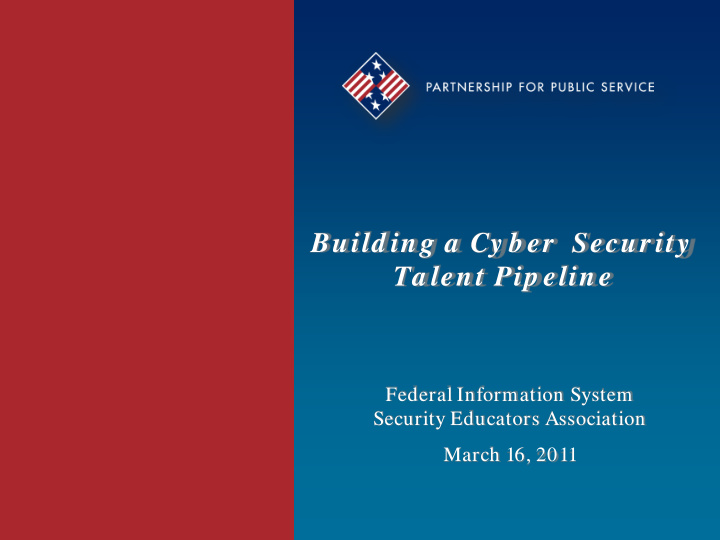



Build ing a Cy b er Security Ta lent Pip eline Federal Information System Security Educators Association March 16, 2011
The Partnership for Public Service The Partnership for Public Service is a nonprofit, nonpartisan organization that works to revitalize our federal government by inspiring a new generation to serve and by transforming the way government works.
Call to Serve Network Call to Serve is a joint effort of the Partnership and the Office of Personnel Management that is committed to reestablishing links between college campuses and federal agencies, and educating students about federal employment opportunities. 740+ colleges and universities, and 76 federal agencies
Barriers to Federal Service Lack of knowledge and understanding Broken hiring process Inadequate student pathways
Barriers to Federal Service: Lack of Knowledge 42% interested in government 13% knowledgeable about opportunities and how to find/ apply Don’t equate governm ent service with public service “Influencers” also lack knowledge
Barriers to Federal Service Students with “mission-critical” backgrounds do not think of the federal government as a potential employer.
Barriers to Federal Service Liberal Arts 34% Natural Sciences 16% IT 13% Business 10% Engineering 9%
Barriers to Federal Service: Hiring Process “Foreign” to job seekers Takes too long Is not transparent Hopefully, hiring reform is addressing this set of issues. How involved are you?
Don’t Do This…
Build Strategic Talent Pipelines Develop strategic, long-term relationships with campuses • Involve key academic departments, relevant student organizations and other groups in your efforts • Target campuses – don’t go simply because you’re invited • Maintain contact even when you’re not actively recruiting!
Build Strategic Talent Pipelines Bring young cyber security specialists to campus Work with faculty to identify skillsets/ coursework necessary for your agency • Example at FERC: electrical engineering + cyber security = power engineering Use internships at sophomore/ junior level and for graduate students • Send back to campus as Student Ambassadors
Understand the Campus Landscape School Infrastructures • Centralized vs. decentralized career services offices • Employer relations teams • Academic advisors and faculty members • Departmental structures
Develop the Right Contacts Your target group should be key influencers with know ledge about and interest in federal jobs • Faculty grant recipients • Former and current federal employees • Government Affairs offices • Community/ Public Service offices • Former and current federal interns
Capitalize on Your Visit Plan additional activities and events • On-Cam pus : Networking nights, internship panels, résumé reviews and/ or practice interviews • Online : Videoconferencing events, webinars, live chats and other social media Follow-up with interested students Connect with faculty members Leave your materials on campus • Strategically place handouts in Career Services or relevant academic departments to keep your brand top of mind for target student groups
Sample Schedule: EPA at Cornell University Morning • Breakfast with Career Services • Student Roundtable Discussion • Classroom Visit Midday • Lunch-and-Learn (RSVP only) • Classroom Visit Evening • General Information Session • Federal Mixer or Networking Night TIP : Survey participants and/ or collect their contact information during your activities
Making the Difference • Hot Jobs/ Cool Internships • Student Program s • 17 interest-specific career guides • Agency profiles • KSA writing and federal resum es • Security clearance • Student loan repaym ent www.m akingthedifference.org 3/31/2011
Tim McManus VP, Education and Outreach 202-775-2759 tmcmanus@ourpublicservice.org www.ourpublicservice.org
Recommend
More recommend